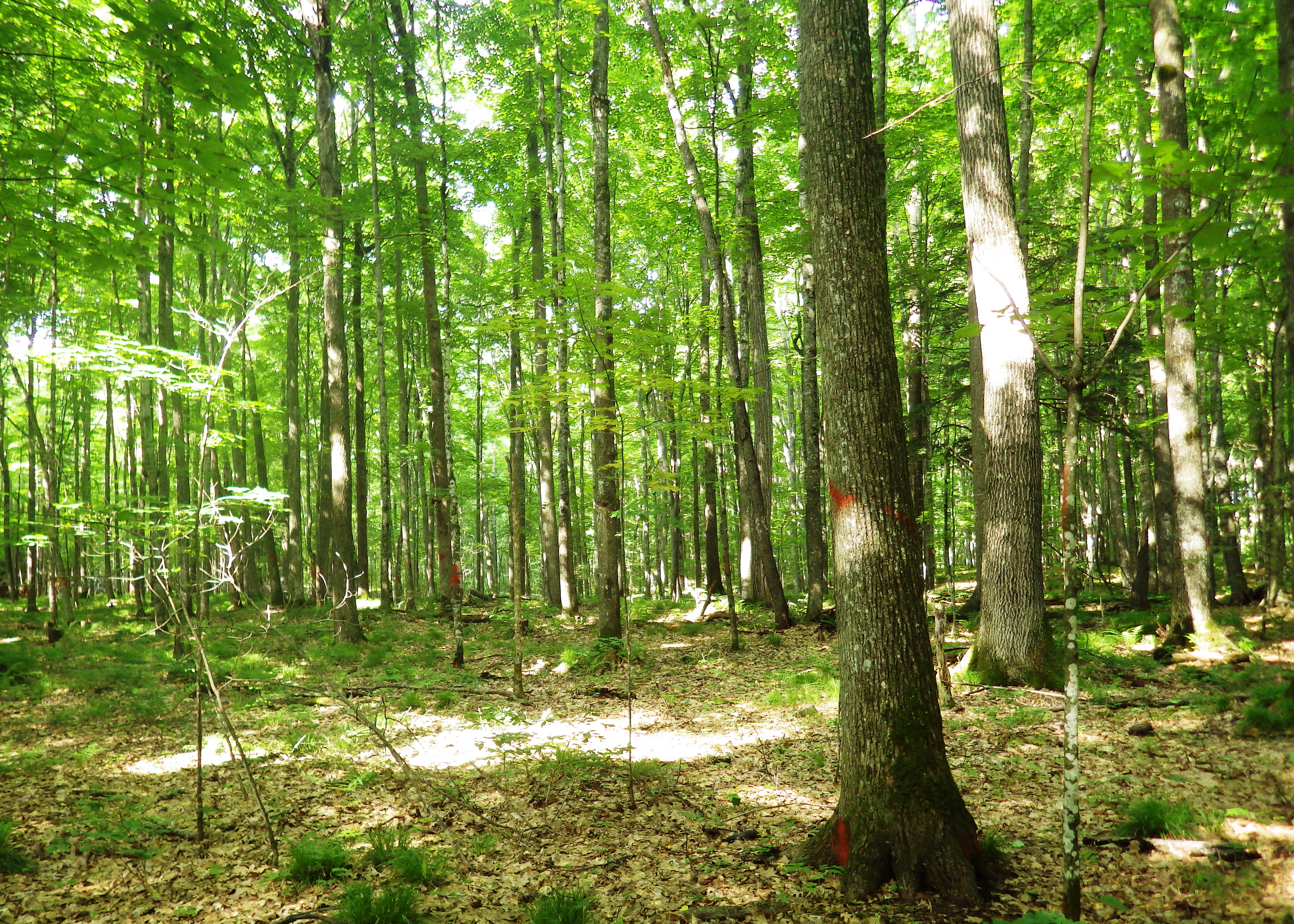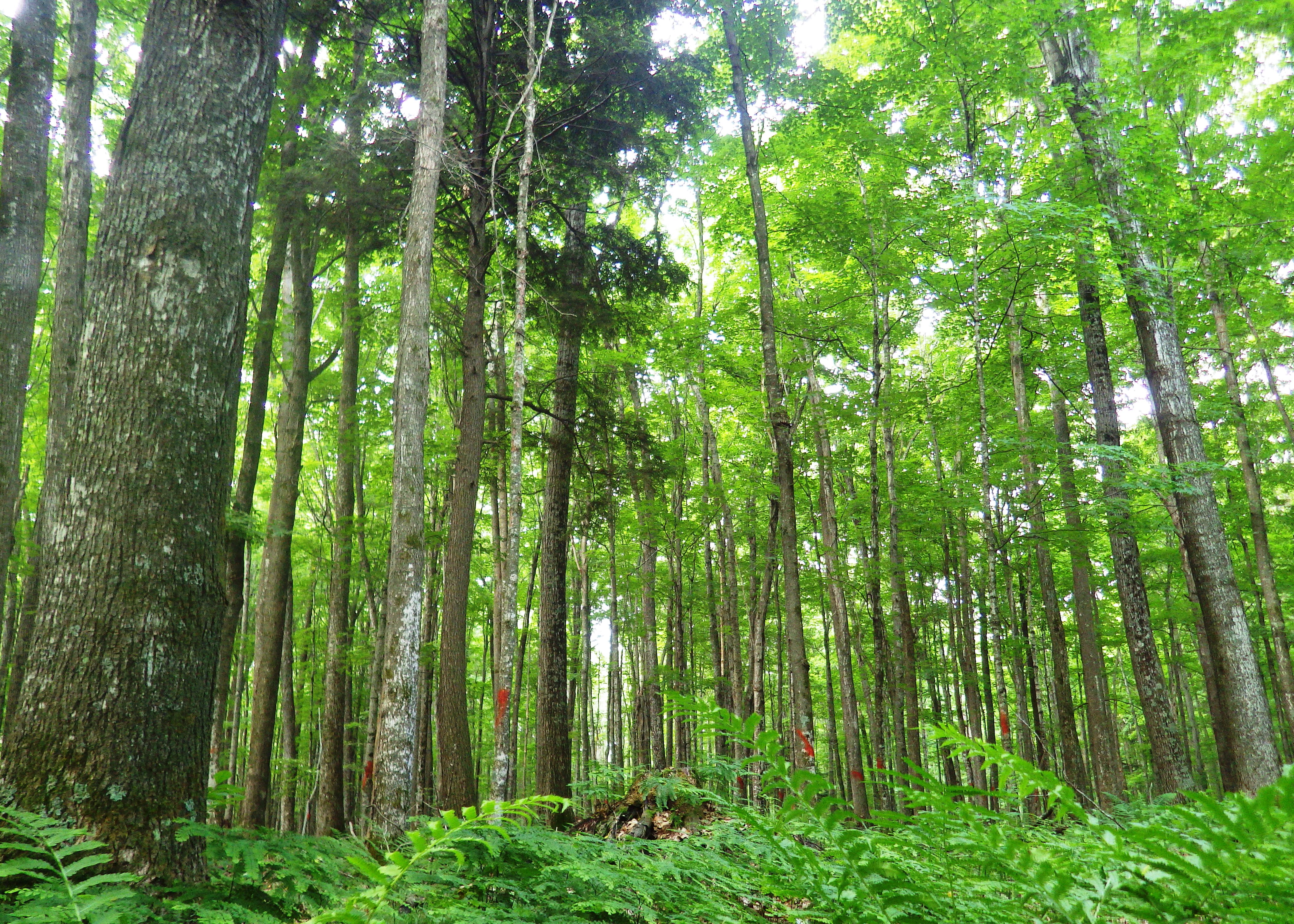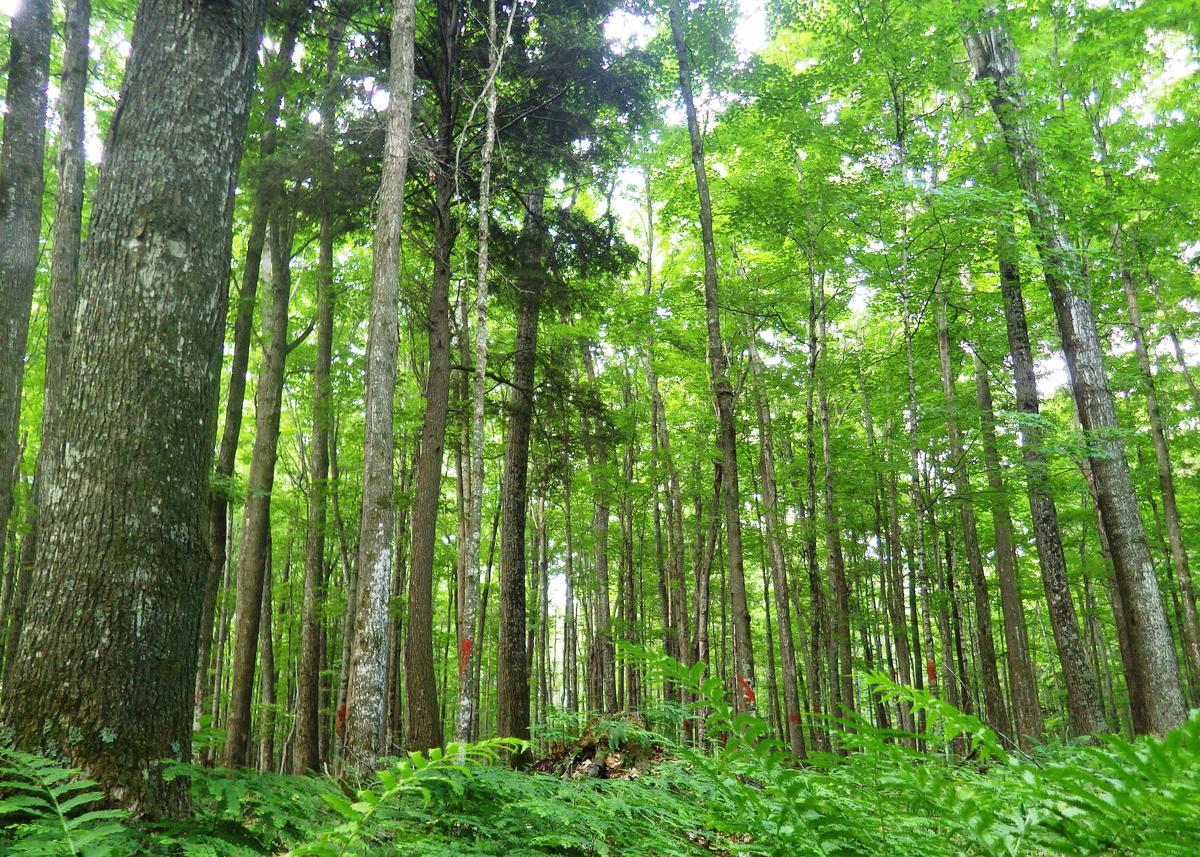Silviculture Objective(s)
The short term goal is to provide income to the owners by commercially thinning the stand, reducing the risk of disease, and enhancing the quality of residual crop trees. The short term objectives:
1 - Promote further crop tree development
2 - Regenerate a new age class through the establishment of canopy gaps (60’ diameter)
3 - Reduce the ash component by 50% in areas where it composes 20% or more of the basal area.
This stand occurs on optimum soils and habitat types for northern hardwood and hemlock/hardwood management. Management will focus on uneven-aged northern hardwood silviculture with the long term objective of promoting forest health and old growth characteristics while producing high quality sawlogs and veneer.

Figure 1: The stand is composed of mostly sugar maple, basswood, northern red oak, and white ash with minor components of other hardwood species and hemlock. The dense canopy has limited the understory to spring ephemerals and a few scattered ferns.
Pre-treatment stand description and condition
Stand establishment and management history:
This stand shares the same history as much of the Stockbridge Munsee land. Timber was heavily cut around the turn of the century (1890-1920) and many areas were cleared for agriculture and/or burned. A light thinning may have been conducted 15+ years ago but only a few rotten stumps can confirm this. No evidence of land uses other than recreation, have been observed within the sale boundaries since the early 1900’s.
Pre-treatment species composition:
|
Species |
Trees/Ac |
BA/Ac |
QMD |
Pulp |
Pulp Top |
Net Saw |
Total Cds |
|
Sugar Maple |
99 |
73 |
11.6 |
15.2 |
4.7 |
1170 |
22.2 |
|
Basswood |
36.5 |
36 |
13.5 |
6.2 |
2.6 |
1283 |
11.4 |
|
N. Red Oak |
17.5 |
23 |
15.5 |
0.8 |
3.1 |
1562 |
7 |
|
White Ash |
12.9 |
13 |
13.7 |
1.8 |
1.2 |
545 |
4.1 |
|
Hemlock |
5 |
3 |
10.9 |
0.8 |
0 |
0 |
0.8 |
|
Blk Cherry |
2.9 |
2 |
10.6 |
0.5 |
0.1 |
23 |
0.6 |
|
Paper Birch |
4.3 |
1 |
7.8 |
0.4 |
0 |
0 |
0.4 |
|
Beech |
3.1 |
1 |
8 |
0.3 |
0 |
0 |
0.3 |
|
Hickory |
0 |
1 |
0 |
0.2 |
0 |
0 |
0.2 |
|
Red Maple |
0 |
0 |
0 |
0 |
0.1 |
23 |
0.1 |
|
Ylw Birch |
0.5 |
0 |
12 |
0.1 |
0 |
0 |
0.1 |
|
Total |
181.6 |
154 |
12.5 |
26.2 |
11.8 |
4607 |
47.2 |
Pre-treatment growth and stocking:
The stand contains high density sawtimber sized northern hardwoods with an average basal area of 154ft2/ac (SE 3%) (35m2/ha). The average diameter (quadratic mean diameter, QMD) of the stand is 12.5” (31.8cm) with a standing volume of 38 cords/ac (340 m3/ha) and 4.607 MBF/ac (27m3/ha) of sawtimber. Tolerant hardwood species comprise 113ft2/ac (26m2/ha) or approximately 73.3% of the total stand stocking, mid-tolerant hardwood species comprise 24% of stand stocking at 37ft2/ac (8.5m2/ha), and intolerant species comprise 3ft2/ac (0.7m2/ha) or 1.9% of the total stand stocking. Besides hickory and paper birch, all timber exhibits good growth and vigor. All species are high quality saw timber. The larger diameter timber has two to three, 8’ sawlogs per tree. Quality hardwood seedling and sapling regeneration is generally lacking.
Pre-treatment forest health issues:
A few diseases are of concern in the area and precautions to prevent the introduction or spread of these diseases will be made. To prevent the infection of pine species by Annosum Root Rot, Cellu-Treat (disodium octabrorate tetrahydrate) or Sporax (sodium tetraborate decahydrate) will be applied to freshly cut stumps. Exception: once temperatures remain below freezing this requirement will be waived. Emerald Ash Borer (EAB) has recently been confirmed in Green Bay, WI, approximately 40 miles (64km) from this stand. White ash composes 8% of the standing volume and is high risk due to the EAB. Where pockets of white ash compose 20% or more of the basal area, an effort will be made to reduce the ash component by 50% in anticipation of the EAB invasion. Nearly all of the bitternut hickory in the area is dead due to the hickory bark beetle and the Ceratocystis smalleyii fungus. Though this disease has all but run its course, the remaining dead hickory timber will be removed to capture any remaining value. Similarly, white birch has reached maturity and is beginning to senesce. In areas with high densities of white birch, larger canopy gaps may be created to allow for the regeneration of intolerant species. Lastly, oak wilt is a prevalent disease in the area and to reduce the risk of spread, no timber will be harvested between April 1st and September 1st.
Landowner objectives/situation:
The following management actions were designed based on the overall forest management goals:
1 - Protection of the forest from commercial and residential development and land use otherwise known as fragmentation.
2 - The entire natural ecosystem shall be maintained and protected in a fashion that does not rely solely on profit-making. The forest shall continue to provide life for the plants, trees, wildlife, water life, and endangered species without destruction to any of these groups.
3 - Develop a triad approach to forest land management in which high conservation value forest areas and intensive high-yield timber management areas can co-exist; surrounded by and embedded within a landscape managed by alternative silvicultural systems that can retain some of the values of old-growth forests.
Converting this stand, using single tree selection, will improve the overall health of the forested ecosystem and enhance the vigor and quality of residual crop trees. For wildlife benefit, a minimum of 2-4 cavity, or potential cavity, trees will be left per acre. If sufficient numbers are not achievable from current stand conditions, live trees may be girdled and left standing.
Silviculture Prescription
The stand will be select cut to retain 70-90ft2/ac (16-21m2/ha) (>5” DBH (12.7cm)) by crown releasing the highest quality dominant and co-dominant trees on a minimum of two sides. If stocking and canopy space allows, 7’ (2.1m) of open space will be provided around released crowns.
Order of removal: Diseased or damaged, high risk, release crop tree, low vigor, merchantable species, and spacing. All things equal, preference will be given to releasing sugar maple, red oak, basswood, red maple, hemlock, yellow birch, and white ash (in that order). Where pockets of high risk or poor quality trees occur, canopy gaps can be cleared. In canopy gaps all non-merchantable hardwood stems, >2” DBH (5cm), will be removed. Canopy gaps should average a 60’ (18.3m) diameter opening to promote regeneration of mid and intolerant species. A minimum residual BA must be maintained outside canopy gaps in order to gain extra tree height.
In areas of hemlock/hardwood (southern boundary) with basal areas >200ft2/ac (46m2/ha), no more than 1/3 of the basal area will be removed. In fully stocked hemlock areas averaging <200ft2/ac (46m2/ha), residual basal areas of no less than 120ft2/ac (27.5m2/ha) will be maintained. Since hemlock does not require the growing space that hardwoods do, residual stocking recommendations are greater. By managing hemlock at these recommended basal areas the residual stand will be better protected against growth loss, increased mortality, and wind-throw. The stand has a few small patches of hemlock and will be marked to these recommendations to reduce the risk of wind-throw. The order of removal will be as stated above however, preference will be given to releasing hemlock, white pine, red oak, sugar maple, and yellow birch (in that order).
All other trees (>5” DBH (12.7cm)) considered “suppressed understory” will be removed. The potential for survival and progression into valuable crop trees is low. Removal of these trees will increase operable space for harvesting equipment, reduce ground competition, and can help to reduce the presence of diseases (like cankers, etc..) that may persist in a stand as long as infected trees remain as hosts. The exception to this rule is hemlock: all healthy hemlock (outside of canopy gaps) should be left to provide ‘color’ and some residual under-story structure. Alternately, all ironwood and balsam fir stems (>3’ (0.9m)) will be removed if it does not jeopardize a crop tree.
What actually happened during the treatment
This harvest has been sold but no harvesting has started. The contractor has until the spring of 2016 to complete the contract. The commercial cruise resulted in a residual stand composition estimate depicted in the table below:
|
Species |
Trees/Ac |
BA/Ac |
QMD |
Pulp |
Pulp Top |
Net Saw |
Total Cds |
|
Sugar Maple |
63.9 |
43 |
11.1 |
4.6 |
3.8 |
1507 |
11.4 |
|
Basswood |
27.9 |
27 |
13.4 |
2.3 |
2.4 |
1383 |
7.5 |
|
N. Red Oak |
10.3 |
16 |
17 |
0.3 |
1.9 |
1286 |
4.8 |
|
White Ash |
3.2 |
2 |
11.5 |
0.2 |
0.2 |
95 |
0.6 |
|
Hemlock |
2 |
2 |
14.6 |
0.6 |
0 |
0 |
0.6 |
|
Blk Cherry |
0 |
0 |
0.1 |
27 |
0.1 |
||
|
Paper Birch |
1 |
0.3 |
0 |
0 |
0.3 |
||
|
Beech |
0 |
0.1 |
0 |
0 |
0.1 |
||
|
Total |
107.2 |
93 |
12.6 |
8.5 |
8.4 |
4298 |
25.4 |
Post-treatment assessment
A post-harvest cruise will be conducted the summer after cutting is completed to determine residual stand characteristics. Five years after sale closure this stand will be surveyed to determine regeneration success using 1/300th acre plots (6.8’ radius) (~1/750th ha, 2.1m). For hardwood regeneration satisfactory stocking is 4,500 stems/ac (11,000/ha), satisfactory stocking for softwoods is 1,250 stems/ac (3,100/ha). Desired species are tolerant and mid-tolerant hardwoods, hemlock, and black cherry.

Figure 2: June photo of the northern hardwood stand with an estimated basal area of 145 ft2/ac and a quadratic mean diameter of 10.9 inches. The pre‐harvest standing volumes are estimated at 28 cords and 5 MBF per acre. The Rx is to leave between 70 and 90 ft2/ac.
Plans for future treatments
No post-harvest treatments should be required to meet management objectives as the stand will be fully stocked with a residual basal area averaging 93ft2/ac (21m2/ha). The basal area is slightly above the target but the true residual after harvests is expected to drop a little and fall within the desired range. If this does not occur, some trees may be girdled. Management of this stand can take two different directions: 1) maintain this stand as a tolerant hardwood type or 2) shelterwood portions of the stands to regenerate mid-tolerant hardwoods (especially northern red oak) while maintaining the heavier hemlock pockets. The decision will hinge on how well regeneration develops; particularly sugar maple and northern red oak. If sugar maple or other acceptable species fail to develop in the established gaps, a shelterwood treatment should be considered within the next one or two rotations. The next scheduled entry is 2035 (20 years).
Costs and economic considerations
This harvest is pretty standard and should be profitable. No site prep or planting costs are expected unless regeneration is insufficient to achieve goals.
Other notes
The Kotar habitat type that best fits the stand is ATM. It occurs commonly throughout the region on well to moderately well drained loams and loamy sands. The moisture regime is mesic with a moderate to high nutrient level. This habitat type represents conditions where soils support near optimal growth and therefore intense competition is exhibited by all native shade tolerant mesic species. Mid tolerant species such as red oak and white ash also do well on this type but in the absence of major disturbance events regeneration will be limited to canopy gaps. The longer the disturbance interval the stronger the sugar maple component will become. Major disturbances are often limited to wind events as an active fire component is generally lacking.
The soils associated with this site are loamy sands to fine loamy sands; Shawano Loamy Fine Sand, Croswell Loamy Sand, Menahga Loamy Sand and Rousseau Loamy Fine Sand with 0-12% slopes. These soils are excessively to moderately well-drained and are rapidly permeable. This soil type will hold up well for logging operations in all but the wettest weather, so seasonal restrictions due to soil structure are not required. Similar to much of the reservation, the parent material is glacial till mixed with sandy outwash plains resulting in the well-drained conditions. Some large boulders are also present across the stand indicative of past glacial activity. A few mucky and poorly drained inclusions are in the general area but will not be part of the harvest area and will be avoided.
Summary / lessons learned / additional thoughts
Forest management is dynamic and the staff will evaluate the management objectives and future strategies once the post-harvest data can be collected.
Submitted by
Paul Koll
Paul Koll has been the head forester for the Stockbridge-Munsee Community for 3 years now (2012). Previously he worked for the USFS JW Toumey Nursery being active in all aspects of nursery operations. Paul graduated from UWSP in 2005 with a BS in Forest Ecosystem Restoration & Management and Michigan Tech. in 2009 with a MS in Forest Ecology & Management.
